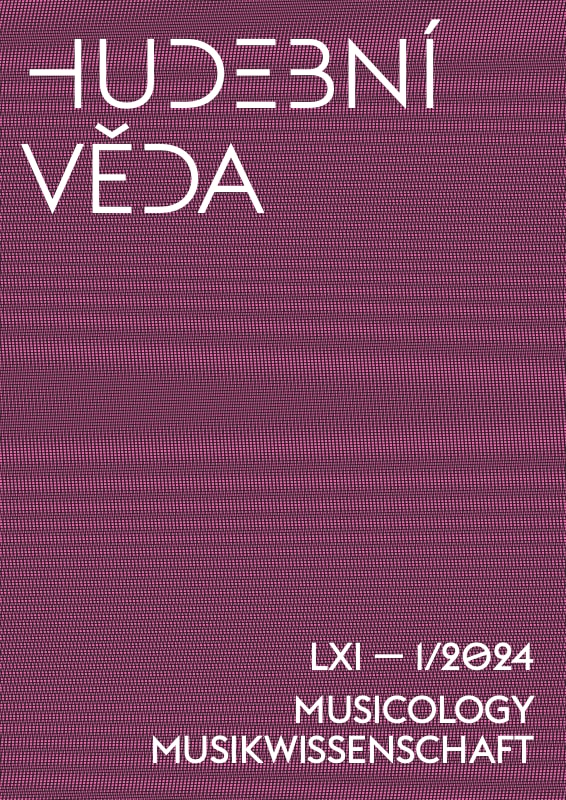Článek | Article
Autor:
David Kozel
Název:
Hudební narativita a mytologické reference Picassiády Karla Kupky
Variantní název:
Musical Narrativity and Mythological References of Picassiáda by Karel Kupka
Zdrojový dokument:
Hudební věda LXI (2024), č. 1, s. 42–72.
DOI:
https://doi.org/10.54759/MUSICOLOGY-2024-0102
Trvalý odkaz:
https://kramerius.lib.cas.cz/uuid/uuid:a5141520-4030-443f-b0d5-d537a3b00a74
České resumé:
Studie analyzuje orchestrální skladbu Picassiáda (1958) ostravského skladatele Karla Kupky (1927–1985) se zaměřením na část Smrt Orfeova. Kupka používá metodu střihové montáže, zapříčiňující specificky vzrušený výraz. Důležitým momentem je inspirace skladby ilustracemi Pabla Picassa k vydání Ovidiových Metamorfóz. Analýza hledá prvky hudební narativity, které prostřednictvím referencí k výtvarné a mytologické složce vytvářejí jedinečný narativní program. Významné místo v Kupkově tvorbě představují skladby na antické náměty. Picassiáda je jeho nejznámější skladbou. V celé Picassiádě je užita metoda střihové montáže s formotvornou funkcí na půdorysu různého formového řešení skladby. Inspirace Picassovými ilustracemi je spíše volná, reflektující moderně cítěný svět antické kultury a mytologie se symbolickým pozadím. Paralela hudebního a uměleckého vyjadřování obou umělců se u Kupky projevuje kontrastními střihy hudebních ploch a kontrastem monumentální a lyrické kresby u Picassa. Kupkovo i Picassovo dílo zachycuje dramatickou a významově víceznačnou smrt mytického Orfea. Narativní analýza skladby je provedena modifikovanou metodologií narativní analýzy dle Eera Tarastiho, který hudební narativitu chápe jako specifickou sukcesivnost hudebních událostí a vytváření tenze mezi binárními hudebními prvky. Organizujícím narativním principem hudby je izotopie. Artikulace hudební narativity Picassiády proběhla na třech úrovních spaciality, temporality a aktoriality. Hudba byla modalizována skrze vztah hudební struktury k mýtu a výtvarné inspiraci. Narativní analýza Picassiády poukázala na specifické významotvorné střídání kontrastních izotopií, sledující narativní strukturu mýtu o Orfeovi. V hudbě narativně figuruje metoda střihové montáže. Modalizace hudby pomocí mýtu je podpůrným způsobem její interpretace, poukázala na hluboké významové propojení hudební a mytologické složky analyzovaného díla.
English summary:
The study analyses the orchestral piece Picassiáda (1958) by Ostrava-based composer Karel Kupka (1927–1985), focussing on the part Smrt Orfeova (in English: The Death of Orpheus). Kupka uses the method of editing assembly, causing a specific excited expression. An important moment of the piece is the inspiration by Pablo Picasso's illustrations accompanying the edition of Ovid’s Metamorphoses. The analysis looks for elements of musical narrative, which create a unique narrative programme by means of references to the artistic and mythological component. Pieces inspired by ancient themes represent an important part of Kupka’s work. Picassiáda is his most famous piece. The editing assembly method is used throughout Picassiáda; it has a form-creating function within the layout of the piece's various forms. The inspiration by Picasso’s illustrations is rather free, reflecting the world of ancient culture and mythology with a symbolic background in a modern way. The parallel of both artists’ musical and artistic expression demonstrates itself in Kupka’s work in the form of contrasting cuts of musical surfaces, and in Picasso’s work by the contrast of his monumental and lyrical paintings. Both Kupka’s and Picasso’s work captures the dramatic and ambiguous death of the mythical Orpheus. The narrative analysis of the piece is carried out with a modified methodology of narrative analysis according to Eero Tarasti, who perceives musical narrative as a specific succession of musical events and the creation of tension among binary musical elements. The organising narrative principle of music is isotopy. The articulation of the musical narrative of Picassiáda takes part at three levels of spatiality, temporality and actoriality. The music is modalised through the relationship of the musical structure to myth and artistic inspiration. The narrative analysis of Picassiáda points to a specific, meaning-forming alternation of contrasting isotopies, following the narrative structure of the Orpheus myth. The method of editing assembly is the narrative element in music. Modalisation of music through a myth is a supporting method of its interpretation; it points to the deep meaning-related interconnection of the musical and mythological components of the analysed work.
Klíčová slova:
Karel Kupka; Picassiáda; Pablo Picasso; hudební narativita; hudební analýza; mýtus; Orfeus; Ostrava
Keywords:
Karel Kupka; Picassiáda; Pablo Picasso; musical narrative; music analysis; myth; Orpheus; Ostrava

